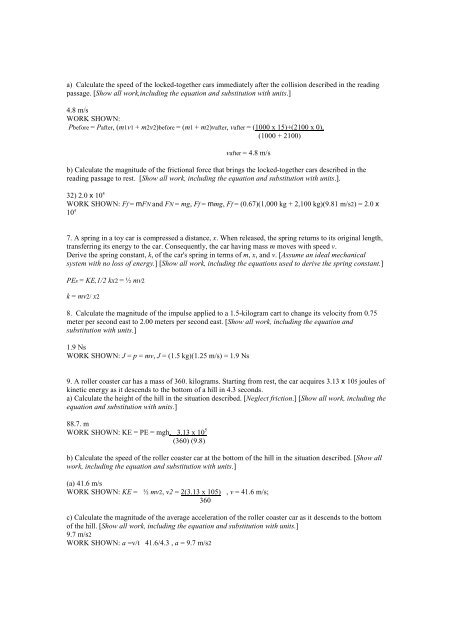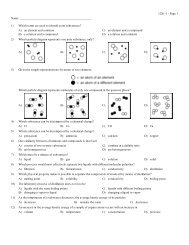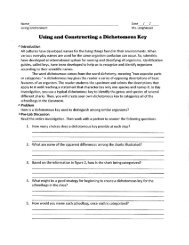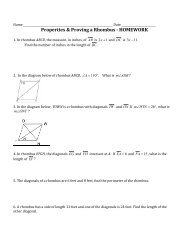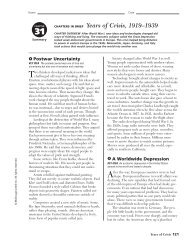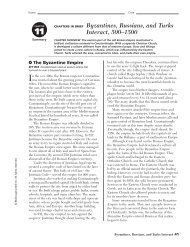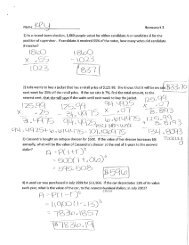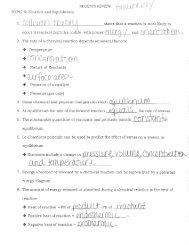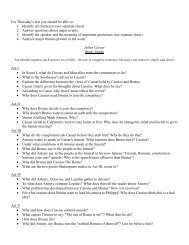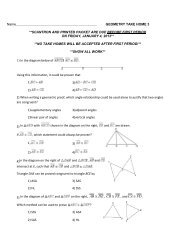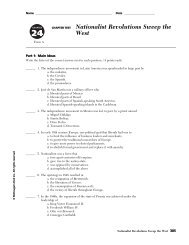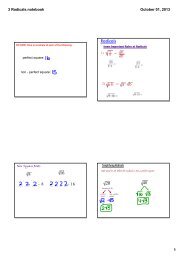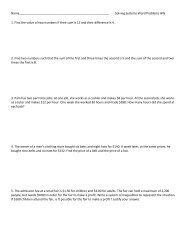Physics Review Answer Key
Physics Review Answer Key
Physics Review Answer Key
Create successful ePaper yourself
Turn your PDF publications into a flip-book with our unique Google optimized e-Paper software.
a) Calculate the speed of the locked-together cars immediately after the collision described in the reading<br />
passage. [Show all work,including the equation and substitution with units.]<br />
4.8 m/s<br />
WORK SHOWN:<br />
Pbefore = Pafter, (m1v1 + m2v2)before = (m1 + m2)vafter, vafter = (1000 x 15)+(2100 x 0),<br />
(1000 + 2100)<br />
vafter = 4.8 m/s<br />
b) Calculate the magnitude of the frictional force that brings the locked-together cars described in the<br />
reading passage to rest. [Show all work, including the equation and substitution with units.].<br />
32) 2.0 x 10 4<br />
WORK SHOWN: Ff = mFN and FN = mg, Ff = mmg, Ff = (0.67)(1,000 kg + 2,100 kg)(9.81 m/s2) = 2.0 x<br />
10 4<br />
7. A spring in a toy car is compressed a distance, x. When released, the spring returns to its original length,<br />
transferring its energy to the car. Consequently, the car having mass m moves with speed v.<br />
Derive the spring constant, k, of the car's spring in terms of m, x, and v. [Assume an ideal mechanical<br />
system with no loss of energy.] [Show all work, including the equations used to derive the spring constant.]<br />
PEs = KE,1/2 kx2 = ½ mv2<br />
k = mv2/ x2<br />
8. Calculate the magnitude of the impulse applied to a 1.5-kilogram cart to change its velocity from 0.75<br />
meter per second east to 2.00 meters per second east. [Show all work, including the equation and<br />
substitution with units.]<br />
1.9 Ns<br />
WORK SHOWN: J = p = mv, J = (1.5 kg)(1.25 m/s) = 1.9 Ns<br />
9. A roller coaster car has a mass of 360. kilograms. Starting from rest, the car acquires 3.13 x 105 joules of<br />
kinetic energy as it descends to the bottom of a hill in 4.3 seconds.<br />
a) Calculate the height of the hill in the situation described. [Neglect friction.] [Show all work, including the<br />
equation and substitution with units.]<br />
88.7. m<br />
WORK SHOWN: KE = PE = mgh, 3.13 x 10 5<br />
(360) (9.8)<br />
b) Calculate the speed of the roller coaster car at the bottom of the hill in the situation described. [Show all<br />
work, including the equation and substitution with units.]<br />
(a) 41.6 m/s<br />
WORK SHOWN: KE = ½ mv2, v2 = 2(3.13 x 105) , v = 41.6 m/s;<br />
360<br />
c) Calculate the magnitude of the average acceleration of the roller coaster car as it descends to the bottom<br />
of the hill. [Show all work, including the equation and substitution with units.]<br />
9.7 m/s2<br />
WORK SHOWN: a =v/t 41.6/4.3 , a = 9.7 m/s2


